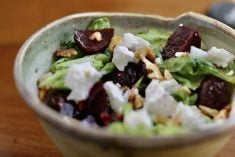Including fresh vegetables in our diets on a daily basis requires a commitment. They require time to clean and prepare. But once this is done, they can become an instant snack food or the basis of a healthy meal.
In my garden I discovered the chives greening up and volunteer spinach poking through and expect asparagus any day. In anticipation, I have found recipes using these spring delights.
Asparagus with chive ties
1 pound asparagus 500 g
4 oz. fresh chives 125 g
1/2 cup butter 125 mL
Read Also

Growing crops for fuel comes with challenges
Crops for sustainable aviation fuel will be the subject of much debate. Where to plant them, will farmers invest in them and how food and fuel prices will be impacted must be discussed.
2 tablespoons fresh tarragon, 30 mL
chopped
1 tablespoon fresh parsley, 15 mL
chopped
grated rind of half a lemon
1 tablespoon lemon juice 15 mL
salt and pepper, to taste
Wash and sort the chives. Wash and trim ends from asparagus spears; tie into bundles of four to six spears using the chives as string. Knot the chives together to form a long enough length to wrap around the bundle twice.
Place bundles in a large pan with about one inch (2.5 cm) boiling water. Cover with a lid and cook for about six to eight minutes, until asparagus is tender but still firm. Or place on a steam rack and steam. Drain well.
Meanwhile, cream together butter, tarragon, parsley, lemon rind, lemon juice, salt and pepper, then heat gently. Arrange asparagus on warmed serving plate, pour butter on top.
Serves four.
Falling in love with vegetables
A recent News release
news introduced me to Mollie Katzen, a leader in the healthy eating movement, author and illustrator of the Moosewood Cookbook, Enchanted Broccoli Forest, Still Life with Menu, Sunlight Café and other best-selling cookbooks. For the past 25 years she has been identified as a spokesperson for vegetarianism. She doesn’t feel she is a vegetarian but rather chooses to cook and eat vegetarian food most of the time.
“What I’m really a proponent of is a garden and orchard-based cuisine in which vegetables and their cousins from the southern end of the food chain, fresh and dried fruit, whole grains, legumes, nuts, herbs, spices and high quality dairy products, are the star players.”
She is also glad that the stigma of vegetarian meals as rabbit food, crunchy hippie food, or just plain spartan and unsatisfying food seems to be fading away. I discovered her website www.molliekatzendesigns.com/news.htm full of great recipes.
Wilted spinach salad
Fresh spinach becomes meltingly tender when wilted by brief contact with hot ingredients. The best spinach leaves to use for this salad are the smallest, freshest you can find.
This tastes best immediately after it has been prepared, when the onion is still warm, the spinach and avocado are at room temperature and the apple slices cold.
1 medium-sized tart green apple
3 tablespoons fresh lemon juice 45 mL
1 small avocado, perfectly ripe
3 tablespoons olive oil 45 mL
2 cups sliced onion (in rings 500 mL
1/2 inch/1 cm wide)
11/2 teaspoons cumin seeds 7 mL
1/2 pound cleaned, stemmed 250 g spinach, in a large bowl
1/2 teaspoon salt 2 mL
freshly ground black pepper
Cut the apple into thin slices onto a plate, and drizzle with about two teaspoons (10 mL) of the lemon juice. Cover the plate tightly, and refrigerate.
Pour the remaining lemon juice onto a second plate. Peel and slice the avocado, then place the slices in the lemon juice. Turn them over until they are well coated. Set aside.
Heat the olive oil in a medium-sized skillet. When it is hot, add the onion rings, and cook over high heat for about two minutes on each side. Sprinkle in the cumin seeds, turn the heat down to medium, and cook for another 30 seconds.
Add the grilled onion rings and cumin to the spinach, and toss until thoroughly mixed. The spinach will wilt upon contact with the hot oil and onion slices. To speed this process along, add some of the spinach directly to the pan and swish it around a little, then return it to the bowl. Sprinkle in the salt as you toss. Gently mix in the avocado, including all the lemon juice, and the apple. Grind in a generous amount of black pepper, and serve right away. Adapted from Mollie Katzen’s Vegetable Heaven.
Serving sizes and obesity
Recent studies indicate that increased serving sizes at home and in restaurants may be a little understood factor in the rise in obesity rates in Canada.
A study in the United States found that since 1977, the sizes of many fast foods have increased dramatically. For example, a burger has increased by 23 percent, french fries by 16 percent and soft drinks by a whopping52 percent. The average size of salty snacks such as potato chips have increased by about 60 percent. These increases in size have meant that the average person is now eating about 148 calories more each day than 20 years ago.
Canada’s Food Guide to Healthy Eating suggests a range of servings from each of the four food groups based on age, body size, activity level, gender and stage of life.
Sheri Taylor, Ann McCormick and Bev Volk the public health nutritionists with the Heartland Health Region, suggest using the following serving size guide to see what one serving looks like.
Grain products (five to 12 servings per day). One serving is:
- One slice of bread.
- Half a small bagel = hockey puck.
- 1/2 cup (125 mL) pasta or rice = one light bulb.
- 3/4 cup (175 mL) hot cereal = one cupped hand.
Vegetables and fruit (five to 10 servings per day). One serving is:
- One medium-sized fruit or vegetable = one tennis ball.
- 1 cup (250 mL) salad = one fist or the size of a baseball.
- 1/2 cup juice = half a small drinking juice box.
- 1/2 cup fresh, frozen or canned fruit or vegetable = one light bulb or the size of three regular ice cubes.
- 1/2 cup cooked vegetable = three spears of broccoli, eight baby carrots or six asparagus spears.
Milk products (two to four servings per day). One serving is:
- 50 g cheese = a tube of lipstick or four dice or two processed cheese slices.
- 1 cup of milk = one small carton of milk (250 mL).
- 3/4 cup of yogurt = one small carton of yogurt (175 g).
Meat and alternatives (two to three servings per day). One serving is :
- 50-100 g meat, fish or poultry = palm of your hand or a computer mouse or one deck of cards or one cassette tape.
- 1/2 -1 cup beans (125-250 mL) = one light bulb.
- 2 tablespoons (30 mL) peanut butter = one ping pong or golf ball.
Fat in foods
The Beef Information Centre has recently updated its booklet A Matter of Fat. This booklet has been a popular nutrition resource for communicating about fat in the diet. It uses the idea of teaspoons of fat contained in foods. Copies can be ordered through the Beef Information Resource Centre at www.beefinfo.org or phone 888-248-2333.
Betty Ann Deobald is a home economist from Rosetown, Sask., and one of four columnists comprising Team Resources. Send correspondence in care of this newspaper, Box 2500, Saskatoon, Sask., S7K 2C4 or contact them at team@producer.com.














